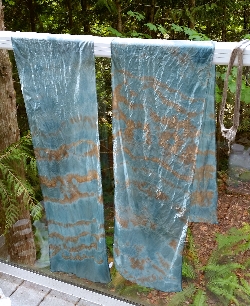
Some friends came over this week to do a couple of dyepots with some dried mushrooms still in my stash. I pulled out a bag of dried toothed fungi that had been sitting in a drawer for a couple of years. When I picked them, I thought they were some sort of Hydnellum, not realizing that in fact I’d collected a good bagful of Phellodon, probably P. atratus, given the amazing blue they gave to the silk scarves in the dypeot. (The mushrooms had soaked overnight in an ammonia solution, which brought the dyepot up to a pH of 10 when we were ready to cook.)
But something interesting happened in the dyepot: Where elastic bands had been used to do some quick shibori, the silk was a coppery brown. At first we thought this might have been a reaction to the rubber in the elastic, but then we noticed this brown showed more faintly where the silk had been tied in loose knots. This warrants more experimenting, for sure. I still have enough of the dried mushrooms for another dyepot, so this is turning out to be an exciting way to start another season of mushroom colours—but first I have to exhaust what’s left in the first pot (these mushrooms seem to be very generous with their pigment; the dye liquor was rich and dark).
This is why I love mushroom dyeing—the learning never stops!

OH MY what a FABulous result! Surprises are the best–when they work out 😉
Yes, we were all in grinning when we saw that blue, and again when we saw the resisted colour. And it’s the surprises that keep it exciting.
The scarves are lovely, beautiful colours. What mordant did you use?
They were mordanted in alum. Now I need to see if I can repeat those results on a silk camisole; then I need to find some more of those same fungi!
complimenti il risultato è davvero sorprendente. Sarà interessante vedere se i risultati si confermano al prossimo dyepot.
Grazie, Pietra. I’ll post the next results soon.
Those are gorgeous! Dyeing must be like magic sometimes.
Yes, dyeing is indeed magic, and I feel as if I’m engaging in the best kind of witchcraft. But if I suggest that I’m using magic mushrooms in my dyepots, people will get the wrong idea!
Since dont have any ammonia can I use something thats alkaline like baking soda or ashes or urine? Have something in the freezer quadriple wrapped with a warning in each layer that think is Hydnellem also. Was under an Oak tree near stream bed.
Try washing soda to bring the pH up to 10 – Miriam Rice suggested that baking soda produces unreliable results. One of my notes from an earlier Fungi & Fibre Symposium indicates that ammonia does a better job of bringing out the blues, so I use that if I can soak and cook outside – you don’t want to use it inside! Also, you need to rinse anything that’s been dyed at pH10, as that can be harsh on the fibres (as will letting the pH get higher than 10). Good look with what you have in the freezer!
We had lots of good color this past weekend at my 24 dyepot workshop, but one disappointment was my very large bag of the Hynd. Imbricatum/or Sarcadon….my first sample (neutral ph) had two nice blues, and a blue gray, but the full pot….containing 7 1/2 pounds of dried mushrooms (ph 10) gave one gray and the rest shades of tan. I was with Miriam Rice in Ft. Ft. Collins many years ago, and she was queen of dyeing with this mushroom, and had exactly the same thing happen. I have a full roaster of this mushroom so will do some tweaking with it later this week to see if I can move it into a blue, any blue.
Aaargh! Not that there’s anything wrong with a nice grey or tan, but still . . . Hope you can coax some blue from it.
Used Ammonia to move that ph as always…..and while it almost always works well when I am just here alone, when doing a large amount for a larger group……….often I get tan, but I am going to play with it a little, making several pots of the large roaster that is full to the top and see if I can coax some blues from it. Have done it before, maybe will do it again…..and I still have around 5 lb. of the dried Hynd. Imp.left in the bag.